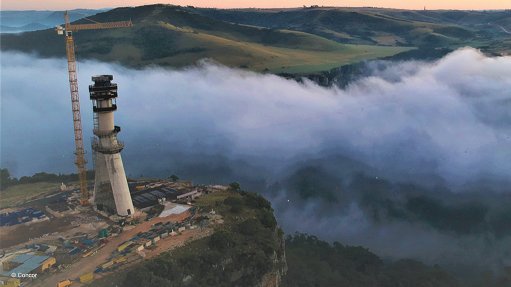
PYLON SUPPORT When complete, the bridge will have a main span of 580 m, supported from a pair of 127-m-tall pylons
Steel company ArcelorMittal South Africa (AMSA) is one of the suppliers to the iconic Msikaba Bridge Project, which is currently under construction near Lusikisiki, in the Eastern Cape.
The cable-stayed steel deck bridge spans the Msikaba river and forms part of the N2 Wild Coast Road Project, which aims to improve the travel time between Durban and East London for heavy freight vehicles.
Steel is a significant component in the “finely engineered design” of this bridge. When complete, the bridge will have a main span of 580 m, supported from a pair of 127 m tall pylons. The deck will be 194 m above the valley floor, making it the third-highest bridge in Africa.
The technical complexity of this project required steel of a higher structural grade and length to be fully developed locally, AMSA says.
“AMSA supported the Msikaba Bridge Project with a considerable investment into product development resources and a reconfiguration of our production assets to ensure that we can produce the required high-strength steel grade and product length for the project,” AMSA CEO Kobus Verster says in a release.
Among other products, the bridge is being fabricated using “world-class” heavy gauge structural steel sections from the ArcelorMittal Rail and Structural Mill, recently launched at the Highveld Industrial Park, in Emalahleni.
It also makes use of structural steel plates of larger length and mass from the reconfigured plant at the company’s Vanderbijlpark Works. The sections are then preassembled before being delivered to site where final assembly takes place, with welding set to happen nearly 200 m above the valley.
“This is a prime example of how local companies can work together to benefit the entire steel value chain,” adds Verster.
“Locally manufactured and fabricated structural steel enables local beneficiation of minerals, easier access for downstream end-use and involves local engineering and technical support that contribute to the project while safeguarding skills,” Verster says, highlighting that the South African steel industry can play a significant role in achieving the country’s industrialisation, infrastructure development and job creation ambitions, “which are all crucial for South Africa’s economic recovery”.